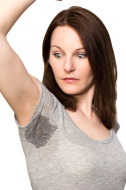Acne Scar | Age Spots | Anal Tag | Cellulite | Dropping Eyelids | Excessive Sweating | Gynecomastia | Hair Removal | Nail Fungus | Rosacea | Skin Lesion | Spider Veins | Stretch Marks | Tattoo | Wrinkle
 Hyperhidrosis refers to frequent or constant excessive sweating. Some individuals sweat more than what is typically needed to cool down the body, a condition that affects nearly 3% of Americans. Hyperhidrosis occurs when the sympathetic nervous system, which controls sweat production, goes into overdrive and causes the sweat glands to produce more sweat than usual. Common areas of the body that are affected by hyperhidrosis include the underarms, palms, and face.
Hyperhidrosis refers to frequent or constant excessive sweating. Some individuals sweat more than what is typically needed to cool down the body, a condition that affects nearly 3% of Americans. Hyperhidrosis occurs when the sympathetic nervous system, which controls sweat production, goes into overdrive and causes the sweat glands to produce more sweat than usual. Common areas of the body that are affected by hyperhidrosis include the underarms, palms, and face.
Primary hyperhidrosis refers to body stimuli that trigger excessive sweating, while secondary hyperhidrosis refers to hyperhidrosis that is associated with an underlying medical condition, such as infection, neurologic or endocrine disorders, and spinal cord injury.
Types of hyperhidrosis:
- Palmar/plantar hyperhidrosis affects the hands/feet.
- Palmar/axillary hyperhidrosis affects the palms/armpits.
- Isolated axillary hyperhidrosis affects only the armpits.
- Craniofacial hyperhidrosis affects the face and head.
Treatment for Excessive Sweating
VaserDry is the subdermal Vaser treatment with new generation of Vaser equipment. This treatment method offers quick recovery time, less tissue trauma, and the use of local anesthetics. The preliminary efficacy for axillary hyperhidrosis is 80-90%.
Botulinum toxin is intradermally injected into the area in which excessive sweating occurs and temporarily freezes the nerve endings in that area to prevent transmission to the sweat glands. the result of injection usually lasts 6-10 months before another injection is needed.





